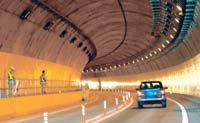Haivan Pass Tunnel
CONSTRUCTION
PROJECT
Welcome to Our Site!
News and Events > Public Media
PM Khai opens Hai Van Tunnel
Date: June 06, 2005
Prime Minister Phan Van Khai (centre) at the ribbon cutting ceremony. ó VNA/VNS Photo The Thuan
Hai Van tunnel opens to traffic. ó VNA/VNS Photo Cong Dien THUA THIEN-HUE ó Prime Minister Phan Van Khai officially opened the Hai Van Tunnel, which links the central province of Thua Thien-Hue to the north and Da Nang City to the south on National Highway No. 1A, yesterday.
Built 1,172m above sea level, the 12km tunnel is the first combined road, tunnel and bridge complex in Southeast Asia and one of the 30 largest and most modern tunnels in the world.
"The tunnel will be cherished by future generations of Vietnamese people," said PM Khai during the opening ceremony at the northern section of the tunnel in Lang Co Village, Phu Loc District in Thua Thien-Hue Province.
Khai said Hai Van Tunnel was the gateway for the East-West Economic Corridor (EWEC), a huge project of ASEAN and the Greater Mekong Subregion (GMS) in particular.
Hai Van Tunnel, which took nearly five years to complete, includes 6.3km of the main tunnel, plus the 6.3km parallel evacuation tunnel, a 1.9km system of cellars for ventilation, and three electrolastic filter systems with 15 cross-passage tunnels.
The tunnel is equipped with a lighting system, a ventilation system, and a special use mechanical hardware system with highly automated and modern functions, according to Transport Minister Dao Dinh Binh.
Binh said the tunnel would help promote economic development in the central region, and in Thua Thien-Hue Province and Da Nang City in particular, by turning the area into an attractive destination for foreign investment.
"The tunnel will help substantially improve traffic conditions over the dangerous Hai Van Pass, shortening the travel distance from 22km to 12 km with a safe, effective and convenient tunnel system," said Binh.
Some 2,500 vehicles use the pass each day, and the tunnel is expected to accommodate from 7,000 to 8,000 vehicles a day by 2007, according to figures from the Project Management Unit 85 (the tunnelís management).
Vehicles are allowed to travel at 80km an hour in the tunnel. It will now take just 10 minutes to cross the Hai Van pass, compared with hours in the past, saving at least VND1000 billion (US$63 million) a year in petrol. Innovation efforts also reduced the construction cost to an estimated $150 million from the initial plan of $251 million.
Binh said the Hai Van Tunnel would pave the way for the GMS traffic corridor, which will run from Central Viet Nam, through central Laos, to northeastern Thailand, and will help boost trade and tourism along the trans-Asia highway.
Akihiko Furya, the director general of the Japan Bank of International Co-operation, said: "Together with the Da Nang Port Improvement Project, which is also supported by Japanese ODA loans, we believe this project (the Hai Van Tunnel) will contribute to economic development in the central region, and to the realisation of the EWEC in the GMS.
Akihiko said with the construction of EWEC, Viet Namís central region is expected to serve as the terminal for freight transport for central Indochina, adding that the central region is also rich in tourism resources, including the beautiful shores and historic sites in Hue, Da Nang, Hoi An and My Son.
"We have high hopes that the opening of the Hai Van Tunnel will accelerate overall regional development and promote these tourism resources, with National Highway No. 1A helping the region become a place tourists will visit," said Akihiko.
He said Japanese firms had a significant interest in the potential of the central region. JBIC began to support the tunnel project in 1997, providing it with total ODA loans of JY18,859 million (US$175.4 million).
However, Akihiko said, the improvement of customs procedures and additional peripheral infrastructures were needed to turn the tunnel into an actual economic corridor and to make the most of it in the coming years.
"In this area, we look forward to the cooperative efforts of the Vietnamese Government and the private sector," said the JBIC director general.
PM Khai asked the Transport Ministry to develop other infrastructure facilities at both sections of the tunnel in Lang Co (Thua Thien-Hue) and Lien Chieu (Da Nang), so that the tunnelís potential could be fully tapped.
"In Lang Co, we could build tourism facilities to lure more tourists, while Da Nang Port could be further developed to attract more foreign ships," said Khai.
He also asked the ministry and provincial authorities of Thua Thien-Hue and Da Nang to strengthen management and maintenance of the Hai Van Tunnel. ó VNS
(Source: Vietnam News)
This homepage is presented by the Consultant Team
Any further question should be forwarded to Webmaster or Consultant Team

